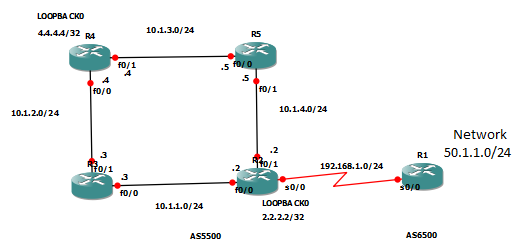SO currently studying BGP for the ROUTE exam. Fired up a little GNS3 Lab.
IN AS5500 I have 4 routers interconnected via different subnets over ethernet for redundancy, using OSPF. The ASBR is connected to AS 6500. They are passing routes no problem.
I created a loopback on the ASBR to talk to the iBGP peer which is not directly connected, (also created the loopback on the iBGP peer). They talk no problem.
Router 2 I issue a neighbor 4.4.4.4 next-hop-self command
Router 4 now shows the routes are valid... but whenever i try to ping all I get is destination unreachable.
Heres the topology.

Also notice there seems to be some routing loop. in OSPF when issuing a traceroute it keeps bouncing back and forth between the same routers before finally finding the route. I disabled router 3 just to see if the potential loop was causing a problem with the BGP route. NO Success.
All routers are Running 12.4(25c) so Its not a sycnh issue.
All OSPF routers have connectivity, so for sake of truncating this already long post I will just ost the configs for R2 and R4 (the two iBGP routers).
ROUTER2
interface Loopback0
ip address 2.2.2.2 255.255.255.255
!
interface FastEthernet0/0
ip address 10.1.1.2 255.255.255.0
duplex auto
speed auto
!
interface Serial0/0
ip address 192.168.1.1 255.255.255.0
encapsulation ppp
clock rate 2000000
!
interface FastEthernet0/1
ip address 10.1.4.2 255.255.255.0
duplex auto
speed auto
!
interface Serial0/1
no ip address
shutdown
clock rate 2000000
!
router ospf 1
log-adjacency-changes
network 2.2.2.2 0.0.0.0 area 0
network 10.1.1.2 0.0.0.0 area 0
network 10.1.4.2 0.0.0.0 area 0
!
router bgp 5500
no synchronization
bgp log-neighbor-changes
neighbor 4.4.4.4 remote-as 5500
neighbor 4.4.4.4 update-source Loopback0
neighbor 4.4.4.4 next-hop-self
neighbor 192.168.1.2 remote-as 6500
no auto-summary
ROUTER4
interface Loopback0
ip address 4.4.4.4 255.255.255.255
!
interface FastEthernet0/0
ip address 10.1.2.4 255.255.255.0
duplex auto
speed auto
!
interface FastEthernet0/1
ip address 10.1.3.4 255.255.255.0
duplex auto
speed auto
!
router ospf 1
log-adjacency-changes
network 4.4.4.4 0.0.0.0 area 0
network 10.1.2.4 0.0.0.0 area 0
network 10.1.3.4 0.0.0.0 area 0
!
router bgp 5500
no synchronization
bgp log-neighbor-changes
neighbor 2.2.2.2 remote-as 5500
neighbor 2.2.2.2 update-source Loopback0
no auto-summary
SORRY for the long post. I am just trying to understand why iBGP is not working, despite R4 showing *> on the show ip bgp summ and installing the path in the routing table.